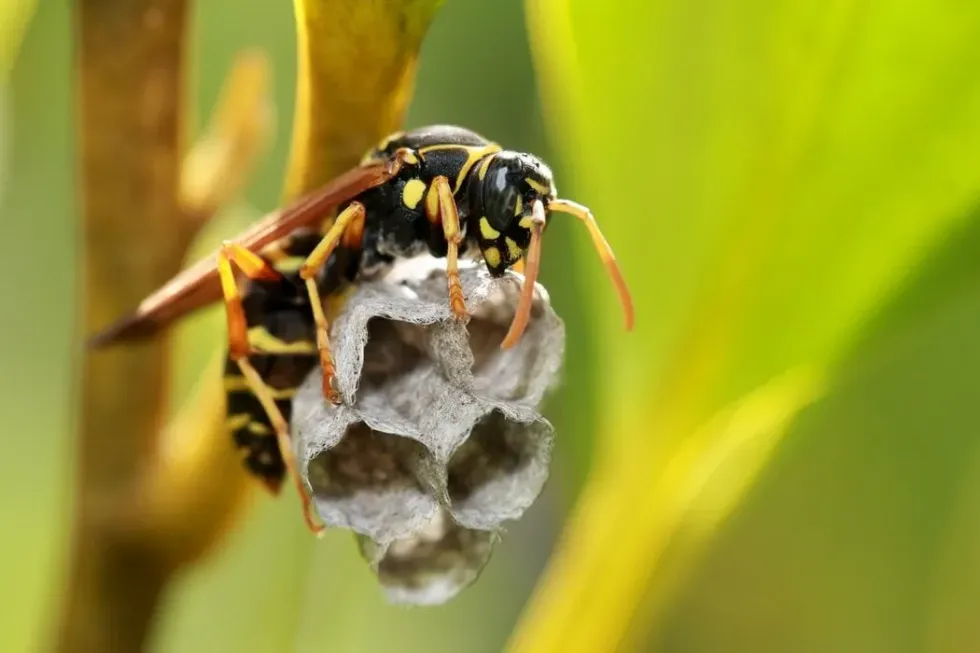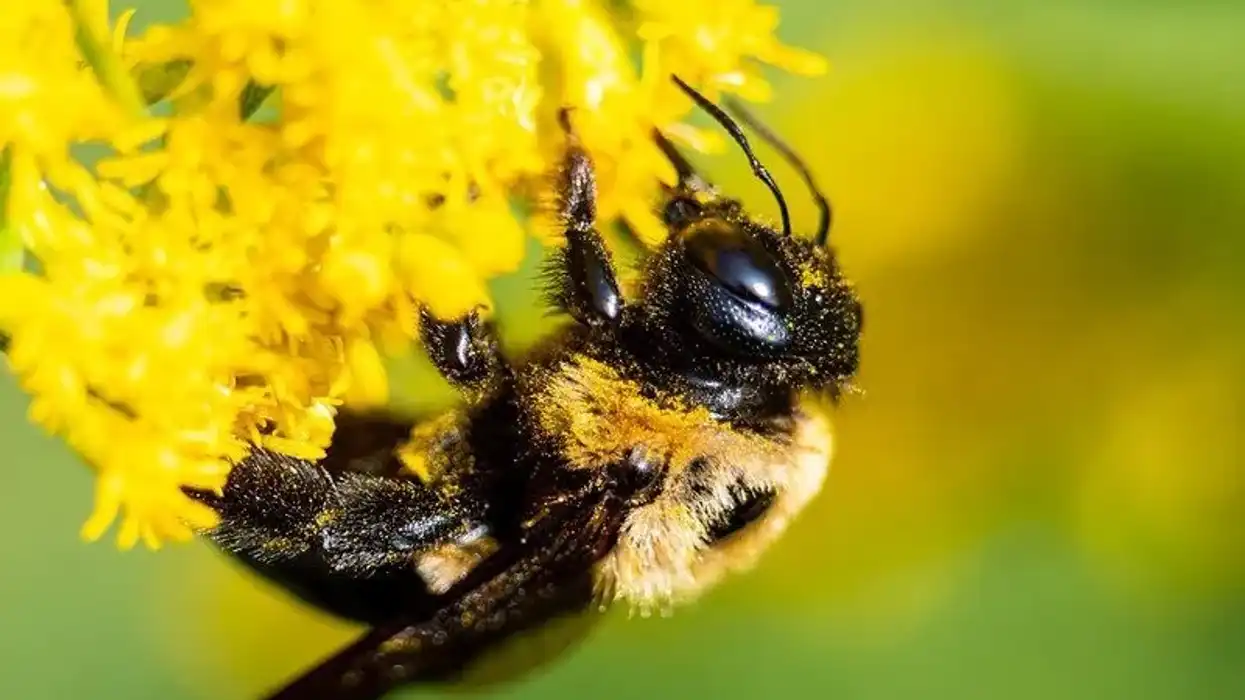Paper wasps are one of the most common stinging wasps encountered by humans in North America, mostly found in the United States, Texas, Florida. There are around twenty-two known species of paper wasp alone in North America and around a hundred more species of them in the world.
They are reddish-brown to black in color with combinations of yellow and orange shades.
They are also characteristically known for their ability to build unique nests out of chewed wood pulp and saliva in order to make them waterproof.
There are various types of paper wasp species that are known such as true paper wasps and umbrella wasps. Paper wasps make their habitat in cracks and crevices of building structures or under tree barks.
The red paper wasp sting is venomous and can cause a lot of pain. Paper wasp nests are prepared from a paper like material with open cells for blood rearing. Here are some interesting European paper wasp facts which you will certainly enjoy. After this, do check out our other articles on squirrel monkey and carrion crow.
Paper Wasp Interesting Facts
What type of animal is paper wasp?
A paper wasp is an insect that is known for its characteristic look and weird yet talented nest-building skills.
What class of animal does a paper wasp belong to?
Paper wasps belong to the class of Insecta and are known to lay hundreds of eggs at once in their specially built open nests.
How many paper wasps are there in the world?
It is almost not possible to know the number of paper wasps (polistes) that are living in this world but it is estimated that there are millions. They are also one of the most common stinging wasps in North America and are believed to have around a hundred more species around the world.
Where does a paper wasp live?
A paper wasp is believed to either live in woods or a house. Wasps usually try to find a spot where they can build their nest and live in them.
What is a paper wasp's habitat?
Paper wasps are known to live in places near human civilization or the wild in order to get enough food. They can be found in small crevices, pipes, or trees near houses. They make their nests in different places in or outside of your house, including roofs or docks, gardens, trees, windows, and many other places.
Who do paper wasps live with?
Paper wasps are really social creatures that live in colonies and are divided among workers, queens, and males. They usually live in a group of 100 paper wasps and slowly die one by one in a life span of one year, and the colony ends.
How long does a paper wasp live?
Paper wasps are known to have a life cycle of 12-22 days but in the case of some species, they are known to live a lot longer. The queen bees are known to live the longest for around a year.
How do they reproduce?
Among the colonies, a female wasp, who is the queen wasp, mates with a male and starts to make a nest when she finds an appropriate locality for building the nest. Workers do not mate, and queen wasp lays eggs, and a new queen wasp further continues to develop their colony.
The eggs are laid in the nest by the queen wasp. A mature paper wasp nest will have around 20-30 adults.
What is their conservation status?
Paper wasps are found all over the world. There are almost 22 known species of paper wasps in North America and there are believed be around a hundred species of them in the world. They are under the least concern according to the status given to them by IUCN.
Paper Wasp Fun Facts
What do paper wasps look like?
A paper wasp is similar to a wasp or insect that is found throughout North America. They are slender, narrow-waisted wasps with long legs, and smoky black wings that are folded lengthwise. A paper wasp is brownish to blackish in color with red or yellow markings with an antenna on its head.
How cute are they?
A paper wasp isn’t actually cute as it can be scary to some individuals due to its capacity to sting. Only experienced people know how to handle these wasps, and the inexperienced should keep away from them.
How do they communicate?
A paper wasp communicates by releasing and smelling pheromones. These pheromones are chemicals that are odorless to humans and are released as a sign of danger to other insects. They can be used to communicate a variety of things including protecting their home, leaving messages regarding the source of food, for mating, and much more.
How big is a paper wasp?
A paper wasp is around 0.75-1 in long and can weigh up to 0.002 lb. They can also grow as large as 1.5 in as well. They are comparatively smaller and around ten times the size of an ant.
How fast can paper wasps move?
Most paper wasps are known to fly at a normal speed of just a few miles per hour. But if you tend to destroy or provoke a paper wasp they have the ability to chase you at a much higher speed. They are really vicious and can sting you, which can be really painful.
How much does a paper wasp weigh?
A paper wasp is not very heavy. Rather it is really small and can weigh up to 0.002 lb. However, its small size is the least concern as its sting can be really painful.
What are their male and female names of the species?
As we have seen, paper wasps are really social creatures that live in colonies, and the queen paper wasp (female) mates with other male paper wasps in order to lay eggs. There are no specific names given to male and female species of paper wasps.
What would you call a baby paper wasp?
A paper wasp gives birth to young ones, and these babies or young ones are called a larvae. Baby wasps or baby paper wasps must pupate adults before they are able to fly.
What do they eat?
Some paper wasps are carnivores while others are herbivores, whereas they are believed to be omnivores as they eat and plants, woods, insects, caterpillars, and much more. They are also known to find various beetles, insects, and caterpillars which they partially feed on and give the remaining part to their younger ones to feed on.
Are they harmful?
No, they are generally not harmful and do not cause any damage to the place where they make their nests. It is advisable to source professional pest control services to get rid of these insects as soon as possible.
Would they make a good pet?
These are great for someone who likes a level of danger and excitement with their pets. They are rather dangerous if their nests are threatened. Rather they do make good pets, but they are equally risky and need precautions. A five gallons aquarium with a lid is a great place to keep your paper wasps and their nests.
Did you know...
Paper wasps cannot bite you, but they sting like honey bees and can sting you several times, unlike honey bees. Their stings can be actually harmful to birds, cats, dogs, or even humans.
It is advised to wear tan, cream, or grey colors around their nests rather than wearing dark colors as they are considered dangerous or threatening by them.
Costs and benefits of paper wasps
They are not too harmful to humans and are known for their nest-building qualities and characteristics. They are usually considered good for places that have gardens as they act as natural pest controllers.
Paper wasp nests
Paper wasps are best known for their unique nests that are built from wood fiber collected from plants that are chewed and mixed with the saliva of a paper wasp to make a paper-like nest of grey or black color. They have hexagonal cells in which each cell contains an egg.
A fully developed or mature paper wasp nest contains around 200 cells and may also rise up to 400 cells in each nest.
Paper wasp nests are also known to resemble an umbrella shape, usually in springtime.
Paper wasps are really protective about their nests and can react aggressively if they sense danger. So, if you want to remove a wasp nest, make sure to wear protective clothing and approach the nest at night when they are less active and spray pesticide spray, smoke, or water on them.
Here at Kidadl, we have carefully created lots of interesting family-friendly animal facts for everyone to discover! Learn more about some other arthropods including cicada killer wasp, or atlas beetle.
You can even occupy yourself at home by drawing one on our Paper wasp coloring pages.









